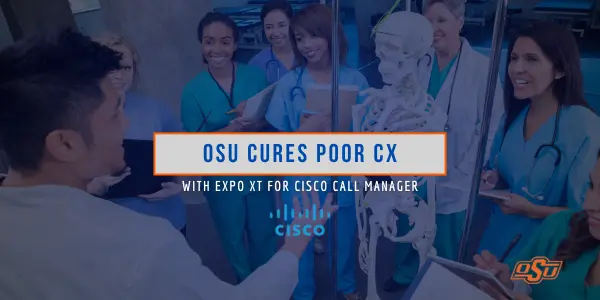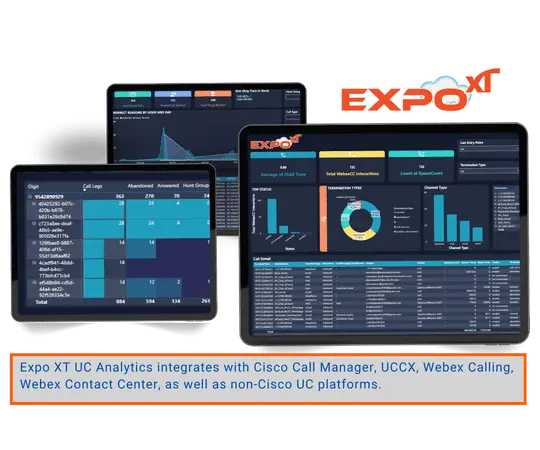


Oklahoma State University (OSU) Center for Health Sciences is a sprawling medical college with a campus in Tulsa as well as numerous clinics spread throughout the state. As a separate entity from OSU's main campus in Stillwater, the Center oversees not just medical education, but also a network of operational healthcare facilities.
This hybrid structure results in a diverse set of call flows and use cases. On the main campus, individual phone numbers are assigned to departments, faculty members, doctors and other staff to facilitate typical business communications. However, at the clinics, a more robust call routing system is required to handle high volumes of incoming patient calls.
The Center's communications are anchored by Cisco Unified Call Manager (UCM) for call control, with Cisco Unity providing voicemail services. Each clinic operates with its own call handler number and a set of hunt groups to queue and distribute calls. These numbers and groups are made available online and through appointment scheduling systems, enabling patients to connect with nurses, book appointments, and address other healthcare-related needs. While this decentralized approach offers flexibility, it also presents challenges in terms of staffing optimization and performance monitoring.
Oklahoma State University's Center for Health Sciences prides itself on delivering high-quality patient care. However, its distributed call center operations were facing significant hurdles that threatened to undermine this commitment. Despite the best efforts of the staff, patients and healthcare providers alike were growing increasingly frustrated with persistent issues.
An influx of complaints highlighted long hold times, missed calls going unanswered, and a lack of visibility into call handling performance. Chris Pepek, the Infrastructure Specialist tasked with resolving these problems, quickly realized that the root cause was an absence of centralized reporting and monitoring capabilities.
"We had a lot of clinics with various configurations in their call routing and hunt groups...We were looking for hard data on where coverage was needed."
- Chris Pepek, Infrastructure Specialist, OSU
Without access to comprehensive data and analytics on key call metrics, it was impossible to pinpoint bottlenecks, quantify the extent of the issues, and implement targeted improvements. Pepek recognized the urgent need to gain insights into critical factors such as:
"We had a lot of clinics with various configurations in their call routing and hunt groups," said Pepek. "But there were concerns and complaints about callers not being able to get someone to pick up or being put on hold forever. We were looking for hard data on where coverage was needed."
With mounting pressure from leadership to resolve the issues, Pepek began searching for a turnkey Cisco UCM and Unity voice reporting and analytics product.
In his search to find a suitable solution, Pepek explored various product offerings, yet many failed to meet expectations. Pepek even conducted a two-week proof of concept, but found the competitor's user interface cumbersome, and that certain desired data fields were inaccessible and unable to be customized. Then he discovered Metropolis Corp's Expo XT UC Analytics solution, which is built upon Microsoft’s Power BI platform and integrates directly with Cisco UCM call data.
"One thing I really liked about Expo XT leveraging Power BI was all the customizability for titles, names, features - all the graphics are fully adjustable," said Pepek. "We were looking for something where every aspect could be changed based on our needs."
Expo XT's integration with the familiar Power BI environment was a big selling point, allowing Pepek to build tailored visualizations and dashboards for different stakeholder groups. Key features that made it a compelling fit:
While having access to call data was crucial, Pepek noted that the ability to shape Expo XT and how it was packaged and consumed was equally important. "If you don't have an IT background and you're not familiar with your call manager, it could be very intimidating with so much data. Being able to customize [the reporting] ourselves was a big plus."

While still relatively early, the initial reports of Expo XT have been positively received by clinic staff and leadership. Pepek has built out over a dozen dashboards customized for different locations, without having to rely on Metropolis' services for every change, and OSU is already realizing valuable use cases:
"When a patient calls and says they left a voicemail, I can confirm the exact time they called, how long they were on hold, and that they went to the voicemail server," described Pepek. "It gives me visual proof to confirm or deny those situations."
Pepek is working on implementing automated email alerts for high missed call volumes, as well as leveraging historical trends for staffing decisions. He plans to track improvement metrics like:
While hard ROI numbers are still forthcoming, OSU has already seen productivity gains from having data-driven insights to optimize operations, instead of working off fragmented anecdotal feedback.
As for future enhancements, Pepek is enthusiastic about expanding usage of the solution: "If we move to Teams or Webex in the future, I'd love to be able to pull reporting for those platforms into Power BI as well. There's a lot of potential once you have a solid foundation in place."
The university has established that foundation with Expo XT, finally bringing data-driven visibility into an area that had previously lacked insightful analytics capabilities. With measurable call metrics now at their fingertips, OSU's Center for Health Sciences is equipped to drive meaningful operational improvements and enhanced patient experiences across their clinics.
Expo XT provides you visibility into your enterprise regardless of your UC tech stack.
From on-premise UC solutions to cloud-based, Expo XT easily consolidates your data silos into one BI platform.